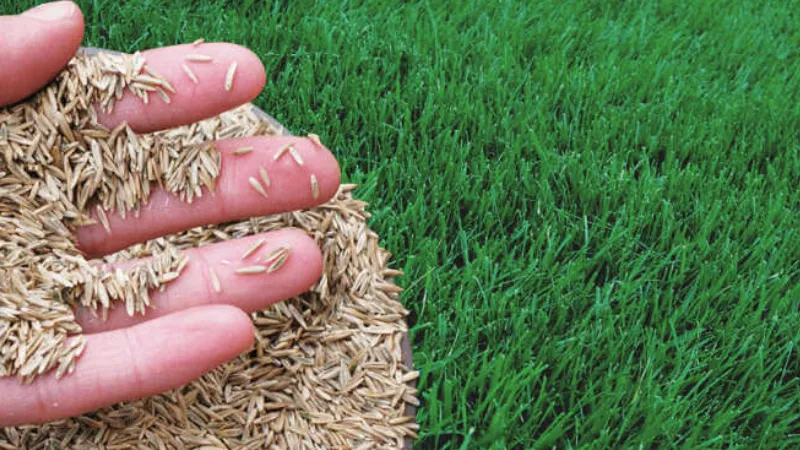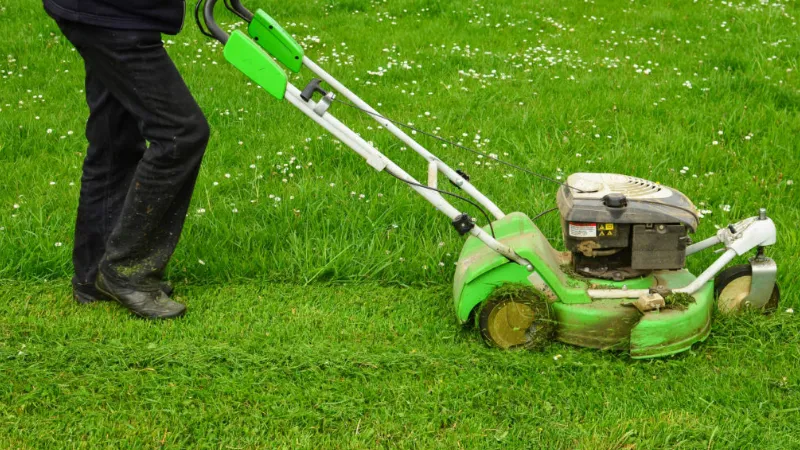Learn how to successfully ensure germination and how long grass seed takes to grow after being sown. To begin with, how long does it take for grass seed to grow?
Most grass seed will start growing in about 30-60 days, but sometimes it can take up to 60 days. It may seem like an eternity when you’re sowing new grass seed in your yard.
Please read on for more detailed information.
Understand Grass Seed Germination
To answer “how long does it take for grass seed to grow”, you need to understand grass seed germination. Following seed planting, the germination period is when grass first begins to grow. The length of germination will primarily depend on the type of seed you use, though other factors such as weather, season, and soil quality also come into play. The length of time required for the germination of some of the most popular grass seeds is listed below.
- Annual Ryegrass: Although it grows quickly and is adaptable, this grass is not very cold tolerant. The average time for germination is five to ten days.
- Bentgrass:On golf course greens, this common perennial cool-season grass is frequently present. It germinates within two weeks.
- Kentucky Bluegrass:This is a hardy grass that’s very tolerant to cold, but it takes longer (between 14-30 days) to germinate.
- Perennial Ryegrass: This common lawn grass tolerates foot traffic well as well. It takes a lot of watering to germinate, but it does so quickly—in just five to ten days.
- Red Fescue: A cool-season grass, it thrives in the shade and uses little water. It will start to grow within 7 to 14 days.
- Zoysia Grass:This is a well-liked warm-season grass that tolerates drought and does well with foot traffic. Zoysia is a slower germinator, though, typically needing between 14 and 21 days.
To develop your lawn maintenance strategy, learn how to identify crabgrass. Below will give you a full explanation of what is crabgrass.

Factors That Affect How Long It Takes Grass to Grow
Find out more about how each of these elements will affect “how long does it take for grass seed to grow”.
Type of Grass Seed
The kind of grass seed you use will, of course, affect how long it takes for it to grow. The majority of grass seed planted here in Northeast Ohio is what are known as cool-season grasses. The ideal temperature range for that kind of grass seed is 60 to 75 degrees Fahrenheit.
In the Northeast Ohio region, Kentucky Bluegrass, Bentgrass, Ryegrass, and Fescue are a few of the most prevalent cool-season grasses.
When the plants aren’t exposed to the summer’s frequently extreme heat and drying conditions, early spring or fall are the ideal times to plant cool-season grasses.
Germination
Another factor in the time it takes for grass seed to grow is germination time. Germination is the process of a seed growing into a plant. Depending on the type of grass seed used, different amounts of time are required for new grass to sprout or germinate.
- Ryegrass: Ryegrass seeds usually grow in 5-10 days
- Fescue: Fescue seeds usually grow in 7-14 days
- Bentgrass: Bentgrass seeds usually grow in 10-14 days
- Kentucky Bluegrass: Kentucky Bluegrass seeds usually grow in 14-30 days
Weather
The weather can affect how long it takes for grass to grow. Cooler than usual temperatures and overwatering from heavy spring rains are two of the most frequent factors that slow down grass growth.
It’s a good idea to look at the long-range forecast before planting, even though you can’t always avoid cooler than usual temperatures or intense rain.
Cool-season grass in Northern Ohio thrives best between 60 and 75 degrees Fahrenheit, as was previously mentioned. You might get better results if you plant during these temperatures.
Soil Conditions
Watch the conditions of your grass’s soil in addition to the ideal weather. How long it takes for grass to grow can be impacted by soil pH. A soil pH between 6.0 and 7.2 is preferred by cool-season grasses.
Water your soil a few days before adding grass seed to try to provide your grass with the best watering conditions. Saturate the ground to a depth of six to eight inches. After planting, water your grass seed one to two times per day, unless rainfall is keeping the soil moist.
And don’t forget to monitor for yard pests. These critters can inhibit grass growth. To encourage faster grass growth, keep hungry pests and destructive bugs away from sensitive grass seed. But, How Long Does Grass Seed Last?

When is the Best Time to Plant Grass Seed?
It’s usually a good idea to plant a lot of grass seeds in the spring, but it’s not always the case. Depending on your location and seed type, you should plant grass seed at the best time. Look for the appropriate warm-weather grass seed if you reside in a mild climate.
The best time to plant seeds for cool-weather varieties may not be in the spring if you live in a cooler climate and need grass seeds for that climate, like Kentucky Bluegrass or Bentgrass. If you live in a warm-weather environment, but you’re headed into the cooler winter months, ask a professional if it’s a good time to seed. You might think about delaying your project until the spring.
Additionally, bear in mind these general temperature-related advice.
- Tip #1: You don’t want to plant a warm-season grass if there’s a threat of frost is within 60 days. In colder regions, consider 90 days.
- Tip #2: Cool-season grasses grow best at daytime temperatures between 60 and 75 degrees.
- Tip #3:When daytime temperatures are below 55 degrees, it’s too late to plant a cool-weather grass.
How Do I Keep My New Lawn Alive?
Appropriate watering is critical to germination as well as the long-term health of your grass. Overwatering could wash the seeds away. Underwatering could prevent the seeds from ever sprouting. Here are four important tips for proper watering:
- Tip #1:You need to create a moist, inviting environment for the seeds to germinate. Several days before planting, you’ll want to water to a depth of six to eight inches.
- Tip #2: Following that, you’ll need to continue watering frequently to keep the top two inches moist but not drenched.
- Tip #3:Watch the lawn closely as the seeds grow. Monitoring the sunny and shady areas will help you understand how the sun affects germination.
- Tip #4: You should give the lawn about one inch of water per week once it is fully established. Water early in the day to prevent evaporation and avoid watering at night because the water may sit on the surface too long and encourage the growth of fungus.
Can you mow wet grass? Short answer: No. Whether it’s early morning and the lawn is still dewy, a rainstorm just ended, or you just ran your sprinklers, you should skip the mow for now. Please read on for more detailed information.

FAQs
How Often Do You Water New Grass Seed?
The most critical element in promoting grass seed germination is watering. During the first two weeks, you may need to water your plants up to four times per day. After that, you can gradually cut back on your watering while lengthening the time your sprinklers run. While seeds require consistent moisture, it’s important to avoid overwatering to the point where water pools or runs off a hill, carrying the grass seed with it.
When Should I Mow New Grass Seed?
Give the entire seeded area some time to take root before even thinking about mowing because not all seeds germinate at the same rate. The newly sprouted grass still needs energy from the blades you can see to support root growth as it continues to develop below the ground.
Although it may be tempting to mow your lovely new lawn right away, wait at least two months before doing so. By that time, the grass should be at least four inches long.
Will Grass Seed Grow If I Just Throw It Down?
You must put forth a little more effort to ensure that you establish a healthy, level turf if you want your new grass seed to grow as intended. In order to support young grass, site preparation and initiatives like mulching aid in the germination of grass seeds and the establishment of healthy soil.
Adding a layer of compost also helps germinated seeds grow strong roots, which is essential to grass health. Some seeds will germinate if you simply throw them in the ground, but the grass won’t be as healthy and the coverage won’t be uniform as it will be if you take the time to prepare the soil.
How Do You Put Down Grass Seed?
You can evenly distribute seed over small areas by using a spreader or by hand. You should adhere to the instructions on the seed package label, which will also specify how much seed is required per square foot of soil.
Summary: How Long Does It Take for Grass Seed to Grow?
This landscaping task can be made more enjoyable rather than frustrating by learning “how long does it take for grass seed to grow?” Consider the type of grass and the anticipated or average temperatures when scheduling the grass planting. Make sure the soil is ready for grass growth and water frequently. These efforts can improve germination rate and time along with the health of your new lawn.
It takes a little bit longer to grow grass from seed than to lay sod or plant plugs. But it saves money and can be rewarding. Just be patient; the time it takes for grass to germinate and grow can differ. Depending on grass type, you can grow a new lawn from seed in 30 to 60 days.
If you have any questions, please leave a comment. My Prime Home tries to give you the best home improvement information. Don’t forget to share the post. Thank you for reading.



